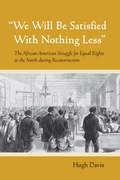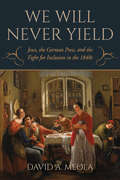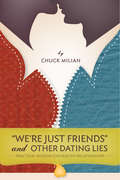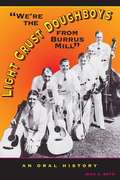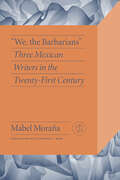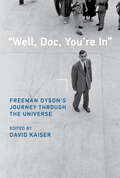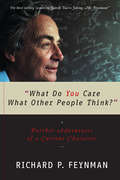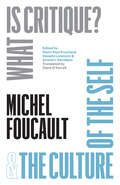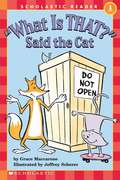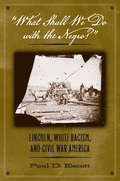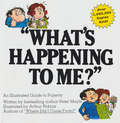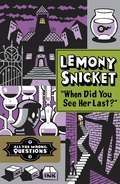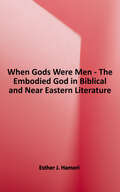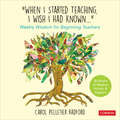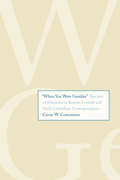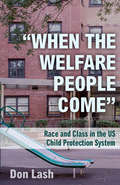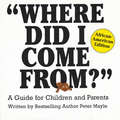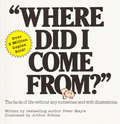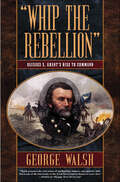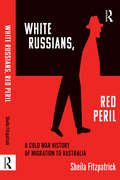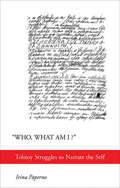- Table View
- List View
"We Never Had a Language for It": Engaging the Emotional Life of the Organization--Assessing a Group's Immunity to Change
by Lisa Laskow Lahey Robert KeganHow do you become a learning organization? As a leader, you cannot grow the organization's ability to achieve its goals alone. Identifying goals as a team and bringing professional development issues to the forefront supports learning on a personal and organizational level simultaneously. This chapter tells the stories of two leadership teams that took on the challenge of identifying roadblocks to change in their organizations and adopted an inclusive approach to leadership development that aligns personal and organizational learning. This chapter is excerpted from "Immunity to Change: How to Overcome It and Unlock the Potential In Yourself and Your Organization."
"We Will Be Satisfied With Nothing Less": The African American Struggle for Equal Rights in the North during Reconstruction
by Hugh DavisHistorians have focused almost entirely on the attempt by southern African Americans to attain equal rights during Reconstruction. However, the northern states also witnessed a significant period of struggle during these years. Northern blacks vigorously protested laws establishing inequality in education, public accommodations, and political life and challenged the Republican Party to live up to its stated ideals. In "We Will Be Satisfied With Nothing Less," Hugh Davis concentrates on the two issues that African Americans in the North considered most essential: black male suffrage rights and equal access to the public schools. Davis connects the local and the national; he joins the specifics of campaigns in places such as Cincinnati, Detroit, and San Francisco with the work of the National Equal Rights League and its successor, the National Executive Committee of Colored Persons. The narrative moves forward from their launching of the equal rights movement in 1864 to the "end" of Reconstruction in the North two decades later. The struggle to gain male suffrage rights was the centerpiece of the movement’s agenda in the 1860s, while the school issue remained a major objective throughout the period. Following the ratification of the Fifteenth Amendment in 1870, northern blacks devoted considerable attention to assessing their place within the Republican Party and determining how they could most effectively employ the franchise to protect the rights of all citizens.
"We Will Never Yield": Jews, the German Press, and the Fight for Inclusion in the 1840s (German Jewish Cultures)
by David A. MeolaHow did German Jews present their claims for equality to everyday Germans in the first half of the nineteenth century? We Will Never Yield offers the first English-language study of the role of the German press in the fight for Jewish agency and participation during the 1840s. David Meola explores how the German press became a key venue for public debates over Jewish emancipation; religious, educational, and occupational reforms; and the role of Jews in German civil society, even against a background of escalating violence against the Jews in Germany. We Will Never Yield sheds light on the struggle for equality by German Jews in the 1840s and demonstrates the value of this type of archival source of Jewish voices that has been previously underappreciated by historians of Jewish history.
"We're Just Friends" and Other Dating Lies
by Chuck MilianSafely Navigating the Dating MinefieldHurt feelings, unmet expectations, dashed hopes, misplaced trust - these are just some of the potential time bombs that explode in dating relationships leaving a trail of broken hearts. Does it have to be this way? Do you have to stop dating to protect yourself and others from deep hurt?As a pastor of a large congregation and former singles pastor, author Chuck Milian has seen firsthand the broken relationships that occur when men and women don't move with proactive care in and through their dating relationships. With pastoral wisdom and insight, Milian educates readers about defining expectations before they start dating, and he outlines a specific five-step dating plan that will help limit relational damage as they look for someone to share their lives with. The author encourages, challenges, and instructs believers in this comprehensive how-to-date handbook. He gives practical advice on wisely forming relationships with the opposite sex while still having fun, avoiding unnecessary hurts, making lifelong friends, and knowing "where they are" each step of the way. Filled with personal reflections and insights, singles will take a look back at their past relational mishaps and move forward into a biblically healthy and romantically fulfilling relationship as God intended it to be. This book remedies and reduces the casualties of the current dating minefield where hearts get broken daily and sometimes never recover.
"We're the Light Crust Doughboys from Burrus Mill": An Oral History
by Boyd Jean A.The Light Crust Doughboys are one of the most long-lived and musically versatile bands in America. Formed in the early 1930s under the sponsorship of Burrus Mill and Elevator Company of Fort Worth, Texas, with Bob Wills and Milton Brown (the originator of western swing) at the musical helm and future Texas governor W. Lee "Pappy" O'Daniel as band manager and emcee, the Doughboys are still going strong in the twenty-first century. Arguably the quintessential Texas band, the Doughboys have performed all the varieties of music that Texans love, including folk and fiddle tunes, cowboy songs, gospel and hymns, commercial country songs and popular ballads, honky-tonk, ragtime and blues, western swing and jazz, minstrel songs, movie hits, and rock 'n' roll.
"We, the Barbarians": Three Mexican Writers in the Twenty-First Century (Critical Mexican Studies)
by Mabel Moraña&“We, the Barbarians&” embarks on a careful and exhaustive reading of three of the most prominent authors in the latest wave of Mexican fiction: Yuri Herrera, Fernanda Melchor, and Valeria Luiselli. Originally published in Mexico in 2021, this work is divided into three parts, one for each author&’s narrative production. The book analyzes all of the literary works published by Herrera, Melchor, and Luiselli from the beginning of their writing careers until 2021, allowing for a diachronic interpretation of their respective narrative projects as well as for comparative approaches to their aesthetic and ideological contours. Characterized by the fragmentation of civil society and the decomposition of the myths that accompanied the consolidation of the modern nation, Mexican visual and literary arts have explored a myriad of representational avenues to approach the phenomena of violence, institutional decay, and political instability. The critical and theoretical approaches in &“We, the Barbarians&” explore a variety of alternative symbolic representations of topics such as nationalism, community, and affect in times impacted by systemic violence, precariousness, and radical inequality. Moraña perceives the negotiations between regional/local imaginaries and global scenarios characterized by the devaluation and resignification of life, both at individual and collective levels. Though it uses three authors as its focus, this book seeks to more broadly theorize the question of the relationship between literature and the social in the twenty-first century.
"Well, Doc, You're In": Freeman Dyson’s Journey through the Universe
by Edited by David KaiserThe life and work of Freeman Dyson—renowned scientist, visionary, and iconoclast—and his particular way of thinking about deep questions.Freeman Dyson (1923–2020)—renowned scientist, visionary, and iconoclast—helped invent modern physics. Not bound by disciplinary divisions, he went on to explore foundational topics in mathematics, astrophysics, and the origin of life. General readers were introduced to Dyson&’s roving mind and heterodox approach in his 1979 book Disturbing the Universe, a poignant autobiographical reflection on life and science. &“Well, Doc, You&’re In&” (the title quotes Richard Feynman&’s remark to Dyson at a physics conference) offers a fresh examination of Dyson&’s life and work, exploring his particular way of thinking about deep questions that range from the nature of matter to the ultimate fate of the universe. The chapters—written by leading scientists, historians, and science journalists, including some of Dyson&’s colleagues—trace Dyson&’s formative years, his budding interests and curiosities, and his wide-ranging work across the natural sciences, technology, and public policy. They describe Dyson&’s innovations at the intersection of quantum theory and relativity, his novel nuclear reactor design (and his never-realized idea of a spacecraft powered by nuclear weapons), his years at the Institute for Advanced Study, and his foray into cosmology. In the coda, Dyson&’s daughter Esther reflects on growing up in the Dyson household. &“Well, Doc, You&’re In&” assesses Dyson&’s successes, blind spots, and influence, assembling a portrait of a scientist&’s outsized legacy. ContributorsJeremy Bernstein, Robbert Dijkgraaf, Esther Dyson, George Dyson, Ann Finkbeiner, Amanda Gefter, Ashutosh Jogalekar, David Kaiser, Caleb Scharf, William Thomas
"What Do You Care What Other People Think?": Further Adventures of a Curious Character
by Ralph Leighton Richard P. FeynmanThe New York Times best-selling sequel to "Surely You're Joking, Mr. Feynman!" One of the greatest physicists of the twentieth century, Richard Feynman possessed an unquenchable thirst for adventure and an unparalleled ability to tell the stories of his life. "What Do You Care What Other People Think?" is Feynman's last literary legacy, prepared with his friend and fellow drummer, Ralph Leighton. Among its many tales--some funny, others intensely moving--we meet Feynman's first wife, Arlene, who taught him of love's irreducible mystery as she lay dying in a hospital bed while he worked nearby on the atomic bomb at Los Alamos. We are also given a fascinating narrative of the investigation of the space shuttle Challenger's explosion in 1986, and we relive the moment when Feynman revealed the disaster's cause by an elegant experiment: dropping a ring of rubber into a glass of cold water and pulling it out, misshapen.
"What Is Critique?" and "The Culture of the Self" (The Chicago Foucault Project)
by Michel FoucaultNewly published lectures by Foucault on critique, Enlightenment, and the care of the self. On May 27, 1978, Michel Foucault gave a lecture to the French Society of Philosophy where he redefined his entire philosophical project in light of Immanuel Kant’s 1784 text “What Is Enlightenment?” Foucault strikingly characterizes critique as the political and moral attitude consisting in the “art of not being governed like this,” one that performs the function of destabilizing power relations and creating the space for a new formation of the self within the “politics of truth.” This volume presents the first critical edition of this crucial lecture alongside a previously unpublished lecture about the culture of the self and three public debates with Foucault at the University of California, Berkeley, in April 1983. There, for the first time, Foucault establishes a direct connection between his reflections on the Enlightenment and his analyses of Greco-Roman antiquity. However, far from suggesting a return to the ancient culture of the self, Foucault invites his audience to build a “new ethics” that bypasses the traditional references to religion, law, and science.
"What Is That?" Said the Cat
by Grace Maccarone Jeffrey Scherer"I found a box", said the fox. "I heard", said the bird. This simple, rhyming, Level 1 "Hello Reader" features the very first sight words new readers learn. Full color. Includes image descriptions.
"What Shall We Do with the Negro?": Lincoln, White Racism, and Civil War America
by Paul D. EscottThroughout the Civil War, newspaper headlines and stories repeatedly asked some variation of the question posed by the New York Times in 1862, "What shall we do with the negro?" The future status of African Americans was a pressing issue for those in both the North and in the South. Consulting a broad range of contemporary newspapers, magazines, books, army records, government documents, publications of citizens' organizations, letters, diaries, and other sources, Paul D. Escott examines the attitudes and actions of Northerners and Southerners regarding the future of African Americans after the end of slavery. "What Shall We Do with the Negro?" demonstrates how historians together with our larger national popular culture have wrenched the history of this period from its context in order to portray key figures as heroes or exemplars of national virtue. Escott gives especial critical attention to Abraham Lincoln. Since the civil rights movement, many popular books have treated Lincoln as an icon, a mythical leader with thoroughly modern views on all aspects of race. But, focusing on Lincoln's policies rather than attempting to divine Lincoln's intentions from his often ambiguous or cryptic statements, Escott reveals a president who placed a higher priority on reunion than on emancipation, who showed an enduring respect for states' rights, who assumed that the social status of African Americans would change very slowly in freedom, and who offered major incentives to white Southerners at the expense of the interests of blacks.Escott's approach reveals the depth of slavery's influence on society and the pervasiveness of assumptions of white supremacy. "What Shall We Do with the Negro?" serves as a corrective in offering a more realistic, more nuanced, and less celebratory approach to understanding this crucial period in American history.
"What Should Inflation Targeting Countries Do When Oil Prices Rise and Drop Fast?
by Eugen Tereanu Nicoletta BatiniA report from the International Monetary Fund.
"What's Happening To Me?": The Classic Illustrated Children's Book on Puberty
by Peter MayleFor more than twenty years, the internationally bestselling team behind Where Did I Come From? has helped millions of parents and children talk about the facts of life in a straightforward yet lighthearted way that is respectful of young people&’s natural intelligence. Warmly and relatably illustrated throughout, What&’s Happening to Me? creates a safe space where families can talk about the physical and emotional changes that happen during puberty and adolescence, answering the questions that kids ask most often. Why is my chest getting bumpy? What's a wet dream?What's a period? Why is my voice acting so funny?Why do I get pimples? What's an erection?Why am I getting hairy? Why is mine not like his? This book answers the big questions, and explains the big changes. One look at the illustrations will tell you that this is not a dull medical textbook but rather it presents the facts of puberty, and it presents them with honesty, sympathy and a sense of humor. If you&’ve been wondering how to have this talk with your children, look no further for a trusted resource that will give you the tools you need to share this critical information sensitively and factually. &“You can't deny Mayle's talent for translating adult experience into child-level concepts.&” —Kirkus Reviews
"When Did You See Her Last?" (All the Wrong Questions #2)
by Lemony Snicket SethI should have asked the question "How could someone who was missing be in two places at once?" Instead, I asked the wrong question -- four wrong questions, more or less. This is the account of the second.In the fading town of Stain'd-by-the-Sea, young apprentice Lemony Snicket has a new case to solve when he and his chaperone are hired to find a missing girl. Is the girl a runaway? Or was she kidnapped? Was she seen last at the grocery store? Or could she have stopped at the diner? Is it really any of your business? These are All The Wrong Questions.
"When Gods Were Men": The Embodied God in Biblical and Near Eastern Literature
by Esther J. HamoriIn the texts of Genesis 18 and 32, God appears to a patriarch in person and is referred to by the narrator as a man, both times by the Hebrew word īsh. In both texts, God as īsh is described in graphically human terms. This type of divine appearance is identified here as the "īsh theophany". The phenomenon of God appearing in concrete human form is first distinguished from several other types of anthropomorphism, such as divine appearance in dreams. The īsh theophany is viewed in relation to appearances of angels and other divine beings in the Bible, and in relation to anthropomorphic appearances of deities in Near Eastern literature. The īsh theophany has implications for our understanding of Israelite concepts of divine-human contact and communication, and for the relationship to Ugaritic literature in particular. The book also includes a discussion of philosophical approaches to anthropomorphism. The development of philosophical opposition to anthropomorphism can be traced from Greek philosophy and early Jewish and Christian writings through Avicenna, Averroes, Maimonides and Aquinas, and into the work of later philosophers such as Hume and Kant. However, the work of others can be applied fruitfully to the problem of divine anthropomorphism, such as Wittgenstein's language games.
"When I Started Teaching, I Wish I Had Known...": Weekly Wisdom for Beginning Teachers
by Carol Pelletier RadfordPractical, thoughtful and inspiring—36 weeks of wisdom for new teachers. Every teacher has those moments, when the learning curve seems too steep, the workload feels too intense, and the faculty room coffee is too weak. But then there’s the moment when they open this book, and smile. Author Carol Pelletier Radford, a mentoring expert, has collected words of wisdom from experienced teachers across the country to help newer teachers thrive. She asked each of them, what is something you wished you knew when you were starting out as a teacher? The responses range from practical classroom management tips to reminders for self-care, and Radford has arranged them into weekly readings that provide advice from a chorus of seasoned educators to help those new to the profession thrive. Highlights include: Start-of-the-year routines for a compassionate culture—and the best classroom management Why consistency and embracing mistakes is important to students—now more than ever How to design experiences that create student engagement—and energize you Questions that help you guide a child toward positive behavior—with fairness, firmness and grace Daily self-care mindsets and rituals—from calming walks to podcasts to learning to say no When I Started Teaching, I Wish I Had Known... takes a teacher gently by the hand, through 36 weeks of the school year. Its practical strategies address lessons, feedback, building relationships, and so much more. But perhaps what this book does most brilliantly is speak to the person behind the teacher, reminding them that they are already gifted, because they are curious and kind.
"When I Started Teaching, I Wish I Had Known...": Weekly Wisdom for Beginning Teachers
by Carol Pelletier RadfordPractical, thoughtful and inspiring—36 weeks of wisdom for new teachers. Every teacher has those moments, when the learning curve seems too steep, the workload feels too intense, and the faculty room coffee is too weak. But then there’s the moment when they open this book, and smile. Author Carol Pelletier Radford, a mentoring expert, has collected words of wisdom from experienced teachers across the country to help newer teachers thrive. She asked each of them, what is something you wished you knew when you were starting out as a teacher? The responses range from practical classroom management tips to reminders for self-care, and Radford has arranged them into weekly readings that provide advice from a chorus of seasoned educators to help those new to the profession thrive. Highlights include: Start-of-the-year routines for a compassionate culture—and the best classroom management Why consistency and embracing mistakes is important to students—now more than ever How to design experiences that create student engagement—and energize you Questions that help you guide a child toward positive behavior—with fairness, firmness and grace Daily self-care mindsets and rituals—from calming walks to podcasts to learning to say no When I Started Teaching, I Wish I Had Known... takes a teacher gently by the hand, through 36 weeks of the school year. Its practical strategies address lessons, feedback, building relationships, and so much more. But perhaps what this book does most brilliantly is speak to the person behind the teacher, reminding them that they are already gifted, because they are curious and kind.
"When You Were Gentiles"
by Cavan W ConcannonCavan W. Concannon makes a significant contribution to Pauline studies by imagining the responses of the Corinthians to Paul's letters. Based on surviving written materials and archaeological research, this book offers a textured portrait of the ancient Corinthians with whom Paul conversed, argued, debated, and partnered, focusing on issues of ethnicity, civic identity, politics, and empire. In doing so, the author provides readers a unique opportunity to assess anew, and imagine possibilities beyond, Paul's complicated legacy in shaping Western notions of race, ethnicity, and religion.
"When the Welfare People Come": Race and Class in the US Child Protection System
by Don Lash&“[An] excellent overview of the child welfare system . . . Most importantly, [the author] provides a discussion of how to create true change.&” —Tina Lee, author of Catching a Case: Inequality and Fear in New York City's Child Welfare System A groundbreaking look at the history and politics of the American child welfare system, &“When the Welfare People Come&” exposes the system in its totality, from child protective investigation to foster care and mandated services, arguing that it constitutes a mechanism of control exerted over poor and working class parents and children. Applying the Marxist framework of social reproduction theory to the child welfare system, the author, an attorney who has practiced in the area of child welfare for more than twenty years, reveals the system&’s role in the regulation of family life under capitalism. &“This book&’s description and analysis of child welfare is terrific. Though I&’ve worked in the field of child welfare for four decades, I learned not only new information but also found new, resonant analyses.&” —David Tobis, PhD, Author of From Pariahs to Partners: How Parents and Their Allies Changed New York City&’s Child Welfare System
"Where Did I Come From?" - African-American Edition
by Peter Mayle Sanders Marcella Sanders&“I give this book top grades for humanness and honesty. Some parents will find that its humorousness helps them over the embarrassment.&” —Dr. Spock Over A Million Copies Sold! An international and beloved bestselling children&’s classic, Where Did I Come From? helps parents and their curious children get up close and personal with the intimate world of human sexuality in the form of a picture book. Told in an age-appropriate voice respectful of young people&’s natural intelligence and warmly and relatably illustrated throughout, Where Did I Come From? creates a safe space where families can learn about the traditional facts of life—from the different parts of the body to orgasm to birth. If you&’ve been wondering how to have this talk with your children, look no further for a trusted resource that will give you the tools you need to share this critical information sensitively and factually. &“The best description of sexual intercourse that is out there for children.&” —Sexedrescue.com &“You can't deny Mayle's talent for translating adult experience into child-level concepts.&” —Kirkus Reviews
"Where Did I Come From?": An Illustrated Children's Book on Human Sexuality
by Peter MayleWith over a million copies sold, this classic children's book has helped parents all over the world discuss the birds and the bees—without any nonsense.First published in 1973, Where Did I Come From? has helped generations of parents talk honestly with their children about the intimate world of human sexuality. Told in an age-appropriate voice respectful of young people's natural intelligence and lightheartedly illustrated throughout, Where Did I Come From? creates a safe space where families can learn about the traditional facts of life—from the different parts of the body to orgasm and birth.If you've been wondering how to have this talk with your children, look no further for a trusted resource that will give you the tools you need to share this critical information sensitively and factually.“I give this book top grades for humanness and honesty. Some parents will find that its humorousness helps them over the embarrassment.” —Dr. Spock
"Whip the Rebellion": Ulysses S. Grant's Rise to Command
by George WalshHow the unprepossessing Ulysses S. Grant, whose military genius ultimately preserved the Union, came to the forefront in the Civil War is a story as surprising as it is compelling. Forced to resign his commission in the peacetime army for drinking, and thereafter reduced to eking out a living for himself and his family with hardscrabble jobs, at the outbreak of hostilities he suddenly found himself a colonel, and then a general, of volunteers. Grant made the most of unexpected commands. what he knew best, it turned out, was how to wage war, relentlessly and with irresistible force.Early in 1862, with the conflict a year old and both sides in the West relunctant to fight, Grant seized the iniative and took Forts Henry and Donelson, capturing an entire rebel army. Later, in Mississippi, he conducted the ardous campaign against Vicksbug, cutting the confederacy in half and capturing a second army. All the time Grant was forced to cope with jealous superiors, like General Henry Halleck, while finding staunch allies in General William Sherman and Admiral David Dixon Porter, and dealing with disloyalty, like that of General John McClernard, who actually came close to replacing him.But for his many victories Grant was named commander in the West, and sent to relieve the seige of Chattanooga, which earned him his promotion to general-in-chief."Whip the Rebellion" was Grant's watchword every day of the war. This dramatic narrative---peopled with the heroics of hundreds of officers and enlisted men, crammed with first-hand accounts of battles, tactics, and civilian hardships---offers fresh insights into both the public and personal lives of Grant and his immediate circle. At the Publisher's request, this title is being sold without Digital Rights Management Software (DRM) applied.
"White Russians, Red Peril": A Cold War History of Migration to Australia
by Sheila FitzpatrickOver 20,000 ethnic Russians migrated to Australia after World War II – yet we know very little about their experiences. Some came via China, others from refugee camps in Europe. Many preferred to keep a low profile in Australia, and some attempted to ‘pass’ as Polish, West Ukrainian or Yugoslavian. They had good reason to do so: to the Soviet Union, Australia’s resettling of Russians amounted to the theft of its citizens, and undercover agents were deployed to persuade them to repatriate. Australia regarded the newcomers with wary suspicion, even as it sought to build its population by opening its door to more immigrants. Making extensive use of newly discovered Russian-language archives and drawing on a lifetime’s study of Soviet history and politics, award-winning author Sheila Fitzpatrick examines the early years of a diverse and disunited Russian-Australian community and how Australian and Soviet intelligence agencies attempted to track and influence them. While anti-Communist ‘White’ Russians dreamed a war of liberation would overthrow the Soviet regime, a dissident minority admired its achievements and thought of returning home.
"Who, What Am I?": Tolstoy Struggles to Narrate the Self
by Irina Paperno"God only knows how many diverse, captivating impressions and thoughts evoked by these impressions . . . pass in a single day. If it were only possible to render them in such a way that I could easily read myself and that others could read me as I do. . ." Such was the desire of the young Tolstoy. Although he knew that this narrative utopia—turning the totality of his life into a book—would remain unfulfilled, Tolstoy would spend the rest of his life attempting to achieve it. "Who, What Am I?" is an account of Tolstoy's lifelong attempt to find adequate ways to represent the self, to probe its limits and, ultimately, to arrive at an identity not based on the bodily self and its accumulated life experience. This book guides readers through the voluminous, highly personal nonfiction writings that Tolstoy produced from the 1850s until his death in 1910. The variety of these texts is enormous, including diaries, religious tracts, personal confessions, letters, autobiographical fragments, and the meticulous accounts of dreams. For Tolstoy, inherent in the structure of the narrative form was a conception of life that accorded linear temporal order a predominant role, and this implied finitude. He refused to accept that human life stopped with death and that the self was limited to what could be remembered and told. In short, his was a philosophical and religious quest, and he followed in the footsteps of many, from Plato and Augustine to Rousseau and Schopenhauer. In reconstructing Tolstoy's struggles, this book reflects on the problems of self and narrative as well as provides an intellectual and psychological biography of the writer.
"Why I Blew the Whistle": Mauro Botta v. PwC
by Jonas Heese Sarah Mehta Aiyesha DeySet in April 2021, this case tells the story of Mauro Botta, a senior manager at PricewaterhouseCoopers (PwC). In 2016, Botta filed a whistleblower claim with the U.S. Securities and Exchange Commission, alleging that PwC had failed to fulfill its obligations to remain independent on several audits dating back to 2012. In 2017, PwC fired Botta. While PwC claimed that the decision had nothing to do with the SEC complaint, Botta believed that the move was retaliatory. In March 2018, he sued PwC for wrongful termination.

